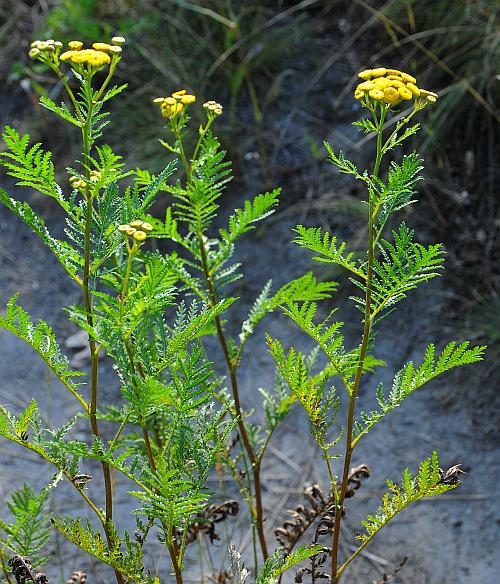Tanacetum vulgare L.
Common Tansy

Introduced
CC = *
CW = 5
MOC = 10
© SRTurner
Tanacetum vulgare L.Common Tansy | |
 |
Introduced CC = * CW = 5 MOC = 10 |
© SRTurner |
|
Family - Asteraceae/Anthemideae Habit - Rhizomatous perennial forb. Stem - Ascending to erect, to 1.5 m, moderately pubescent with short, curly hairs when young, becoming nearly glabrous by flowering time.
Leaves - Foliage strongly aromatic. Leaves alternate and basal, the basal leaves usually withered by flowering time, sessile or short-petiolate. Leaf blades pinnately compound or deeply lobed, oblong-obovate to elliptic in outline, the primary leaflets or lobes 9-21 (with short wings or reduced, accessory lobes between them), these pinnately lobed, narrowly elliptic to lanceolate, rounded to more commonly bluntly pointed at the tip, broadly sessile or short-angled at the base, the margins otherwise sharply toothed, both surfaces moderately to densely glandular but otherwise glabrous or nearly so at maturity.
Inflorescence - Dense terminal corymbiform panicle of flower heads. Peduncles glabrous.
Heads - Discoid. Involucre 3-7 mm long, broadly and shallowly cup-shaped, the bracts in 3-5 series, the main body narrowly oblong-lanceolate to triangular-lanceolate, tapered to a conspicuous, thin, papery tip, the margins also thin and nearly transparent, the outer surface glandular and hairy. Ray florets absent or the marginal florets rarely pistillate, somewhat zygomorphic, but inconspicuous and not markedly enlarged, yellow. Disc florets with the corollas 1.5-2.5 mm long, yellow. Pappus a short collar or crown or absent.
Fruits - Achenes 1.3-1.7 mm long, moderately to strongly 5-angled or 5-ribbed Flowering - July - September. Habitat - Bluff tops, fencerows, roadsides, railroads, open disturbed areas. Origin - Native to Eurasia Lookalikes - Tanacetum balsamita. Other info. - This species is uncommon in Missouri, so far known from only a few widely scattered counties. All but five Missouri records were collected prior to 1950. The plant is far more common in northern and western regions of the country, and is considered a noxious weed in some areas of the Rocky Mountains. It is easy to recognize, with the combination of "yellow button" flowering heads and dissected foliage being sufficient for a positive ID. Photographs taken at a rest stop in Granite County, MT (SRTurner). |